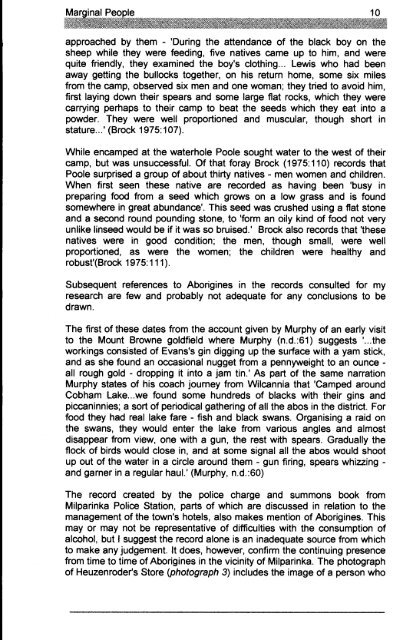Adec Preview Generated PDF File - The Sydney eScholarship ...
Adec Preview Generated PDF File - The Sydney eScholarship ...
Adec Preview Generated PDF File - The Sydney eScholarship ...
You also want an ePaper? Increase the reach of your titles
YUMPU automatically turns print PDFs into web optimized ePapers that Google loves.
approached by them - 'During the attendance of the black boy on the<br />
sheep while they were feeding, five natives came up to him, and were<br />
quite friendly, they examined the boy's clothing... Lewis who had been<br />
away getting the bullocks together, on his return home, some six miles<br />
from the camp, observed six men and one woman; they tried to avoid him,<br />
first laying down their spears and some large flat rocks, which they were<br />
carrying perhaps to their camp to beat the seeds which they eat into a<br />
powder. <strong>The</strong>y were well proportioned and muscular, though short in<br />
stature...' (Brock 1975: 107).<br />
While encamped at the waterhole Poole sought water to the west of their<br />
camp, but was unsuccessful. Of that foray Brock (1975:110) records that<br />
Poole surprised a group of about thirty natives - men women and children.<br />
When first seen these native are recorded as having been 'busy in<br />
preparing food from a seed which grows on a low grass and is found<br />
somewhere in great abundance', This seed was crushed using a flat stone<br />
and a second round pounding stone, to 'form an oily kind of food not very<br />
unlike linseed would be if it was so bruised.' Brock also records that 'these<br />
natives were in good condition; the men, though small, were well<br />
proportioned, as were the women; the children were healthy and<br />
robust'(Brock 1975:111).<br />
Subsequent references to Aborigines in the records consulted for my<br />
research are few and probably not adequate for any conclusions to be<br />
drawn.<br />
<strong>The</strong> first of these dates from the account given by Murphy of an early visit<br />
to the Mount Browne goldfield where Murphy (n.d.:61) suggests '...the<br />
workings consisted of Evans's gin digging up the surface with a yam stick,<br />
and as she found an occasional nugget from a pennyweight to an ounce <br />
all rough gold - dropping it into a jam tin.' As part of the same narration<br />
Murphy states of his coach journey from Wilcannia that 'Camped around<br />
Cobham Lake...we found some hundreds of blacks with their gins and<br />
piccaninnies; a sort of periodical gathering of all the abos in the district. For<br />
food they had real lake fare - fish and black swans. Organising a raid on<br />
the swans, they would enter the lake from various angles and almost<br />
disappear from view, one with a gun, the rest with spears. Gradually the<br />
flock of birds would close in, and at some signal all the abos would shoot<br />
up out of the water in a circle around them - gun firing, spears whizzing <br />
and garner in a regular haul.' (Murphy, n.d.:60)<br />
<strong>The</strong> record created by the police charge and summons book from<br />
Milparinka Police Station, parts of which are discussed in relation to the<br />
management of the town's hotels, also makes mention of Aborigines. This<br />
mayor may not be representative of difficulties with the consumption of<br />
alcohol, but I suggest the record alone is an inadequate source from which<br />
to make any judgement. It does, however, confirm the continuing presence<br />
from time to time of Aborigines in the vicinity of Milparinka. <strong>The</strong> photograph<br />
of Heuzenroder's Store (photograph 3) includes the image of a person who




